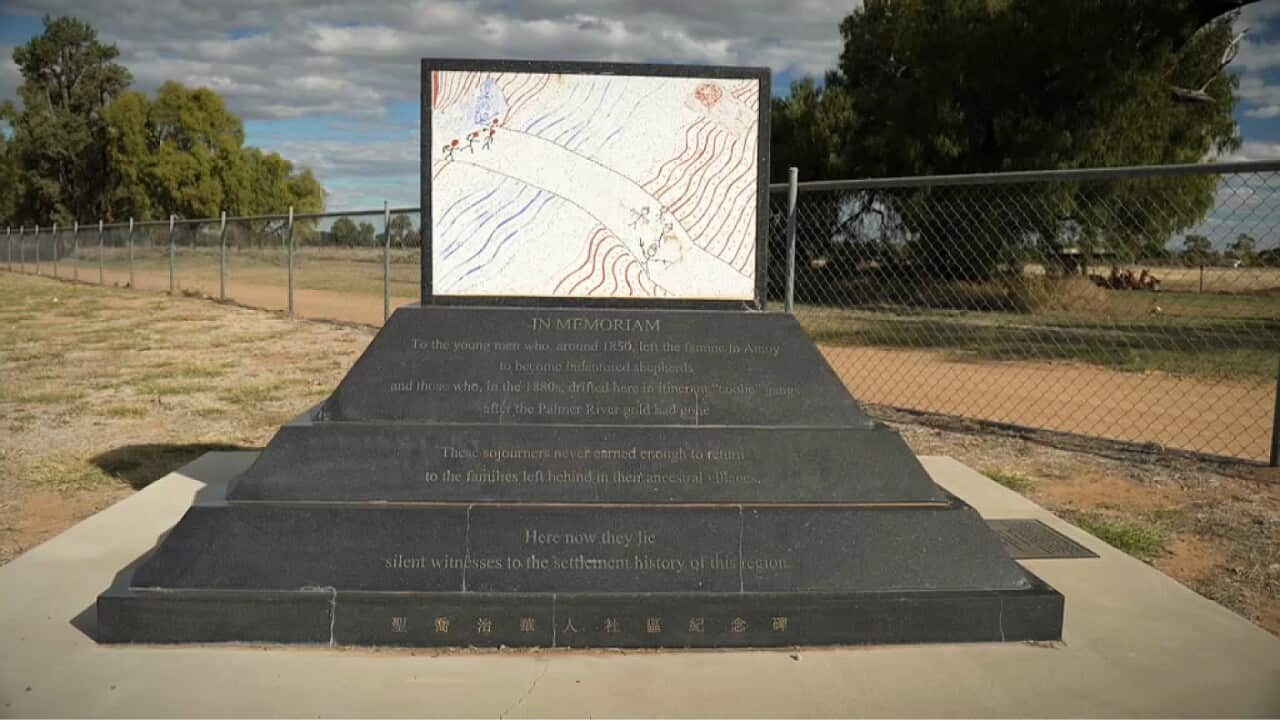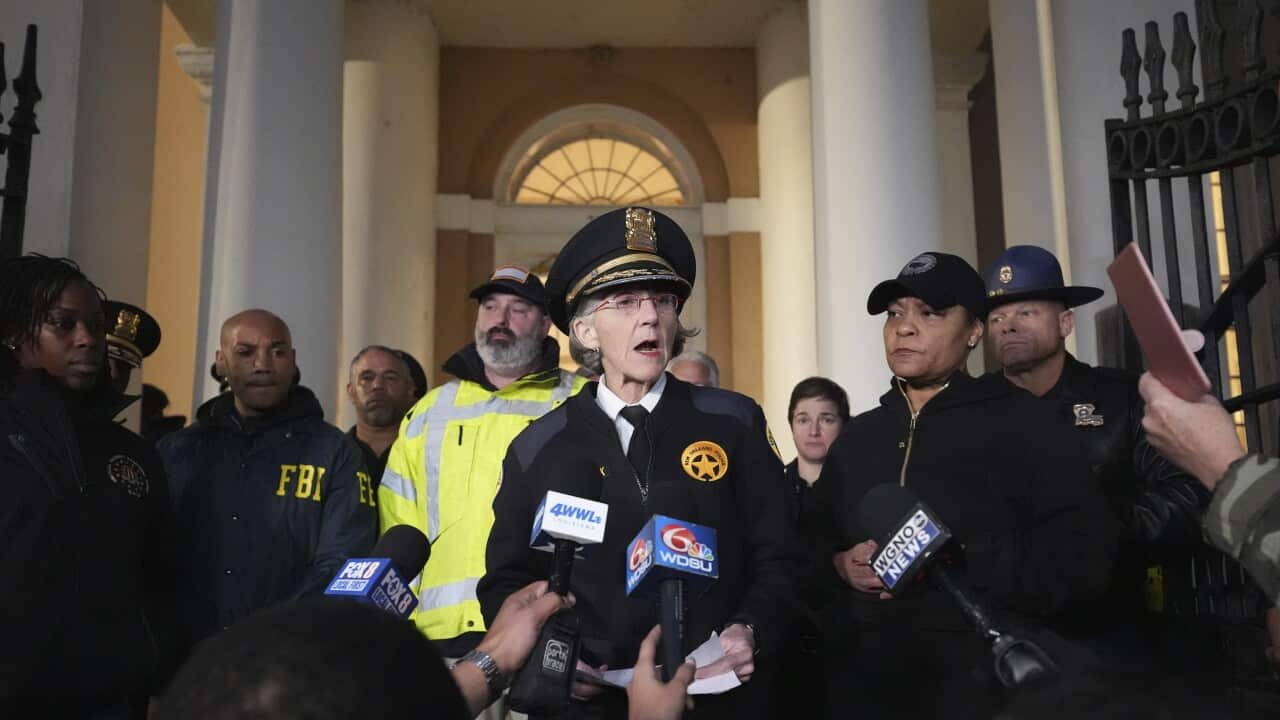English
Nearly 300 Chinese indentured labourers who came to Australia in 1840 were remembered at a memorial service in a tiny town in St George, nestled in the Balonne Shire Council.
Samantha O'Toole is the Council Mayor.
"At the time that would've been a very significant part of the population that's here and a number of those descendants were never able to raise enough money or able to return home and so generations that have come since then, we have large numbers of their descendants in their community today."
Poorly paid, they tended more than 450,000 sheep - with hardly a mention of them in national history - and just one of them with their own marked grave today.
Ruan Zongzee is Brisbane's Chinese Consul General, with this to say, in his speech.
"They overcame unimaginable difficulties, make great sacrifices, and eventually lay to rest here. Their names might not be known, however, they are all bear the same name: Chinese."
At the service, organisers laid wreaths and poured three small glasses of wine onto the monument floor - a Chinese symbol of heaven, earth and ancestors.
Western and Chinese customs merged for those whose stories have been unearthed by a dedicated Chinese community group.
Lewis Lee is a member of the St George Chinese Community Memorial Committee.
"There was no record of [the labourers] at all. One of the reasons may be that [locals] didn't even care about the existence of Chinese here."
Their memory has been kept alive by their descendants, and traces of the Chinese community that still remain.
"People will be talking about Chinese and I'm like, 'I'm Chinese', and they look at me, like no you're not, and I'm like, 'I am'."
Cheryl Horneman's family came during the Gold Rush and stayed to become shepherds and butchers, but doesn't know where her great grandfather was laid to rest.
"My great grandfather, he's buried up there in the cemetery and years ago, they wouldn't let Chinese be buried in the cemetery, they've have to be buried on the outside and then a fire came through n 1975 and burnt all the wooden headstones around their graves and it was all wiped out. So no one really knows where they were buried anymore."
But a monument built in their honour ensures that won't ever happen. An artwork designed by Kamilaroi teenager Daisy Brown, shows her ancestors welcoming Chinese settlers along the Balonne River.
"It's just meaning that they're coming together to be able to make peace and I just thought it was really important to put that in there, so they're meeting in the middle."
As the Chinese labourers rest along the outskirts of this rural graveyard, the words etched into the monument pertinently read: "here, now they lie, silent witnesses to the settlement history of this region".
Italian
Circa 300 lavoratori cinesi schiavizzati, che vennero in Australia nel 1840, sono stati ricordati in una commemorazione che ha avuto luogo in una minuscola cittadina a St George, situata nel Balonne Shire Council.
Samantha O'Toole è la sindaca del Council.
"At the time that would've been a very significant part of the population that's here and a number of those descendants were never able to raise enough money or able to return home and so generations that have come since then, we have large numbers of their descendants in their community today."
Sottopagati, badarono a più di 450,000 pecore – senza essere quasi mai menzionati nella storia nazionale – e soltanto uno, ad oggi, ha il proprio nome sulla sua tomba.
Ruan Zongzee è il console generale cinese di Brisbane, ed ha voluto dire questo nel suo discorso.
"They overcame unimaginable difficulties, make great sacrifices, and eventually lay to rest here. Their names might not be known, however, they are all bear the same name: Chinese."
Alla funzione, gli organizzatori hanno deposto corone di fiori e versato tre piccoli bicchieri di vino sul pavimento del monumento – un simbolo cinese per paradiso, terra e antenati.
Costumi occidentali e cinesi si sono fusi per coloro le cui storie sono state portate alla luce da un impegnato gruppo comunitario cinese.
Lewis Lee fa parte del comitato del St George Chinese Community Memorial.
"There was no record of [the labourers] at all. One of the reasons may be that [locals] didn't even care about the existence of Chinese here.
Il loro ricordo è stato tenuto in vita dai loro discendenti, e da tracce della comunità cinese che ancora permangono.
"People will be talking about Chinese and I'm like, 'I'm Chinese', and they look at me, like no you're not, and I'm like, 'I am'."
La famiglia di Cheryl Horneman arrivò durante la corsa all’oro e rimase, diventando in seguito pastori e macellai, ma Cheryl non sa dove sia sepolto il suo bisnonno.
"My great grandfather, he's buried up there in the cemetery and years ago, they wouldn't let Chinese be buried in the cemetery, they've have to be buried on the outside and then a fire came through n 1975 and burnt all the wooden headstones around their graves and it was all wiped out. So no one really knows where they were buried anymore."
Ma un monumento costruito in loro onore sta lì ad assicurare che questo non accada più. Un’opera realizzata dall’adolescente della nazione Kamilroi Daisy Brown mostra i suoi avi che danno il benvenuto ai coloni cinesi lungo il fiume Balonne.
"It's just meaning that they're coming together to be able to make peace and I just thought it was really important to put that in there, so they're meeting in the middle."
E mentre i braccianti cinesi riposano lungo i margini di questo cimitero di campagna, le parole scolpite nel monumento recitano: “qui, ora riposano, silenti testimoni della storia dell'insediamento in questa regione".




